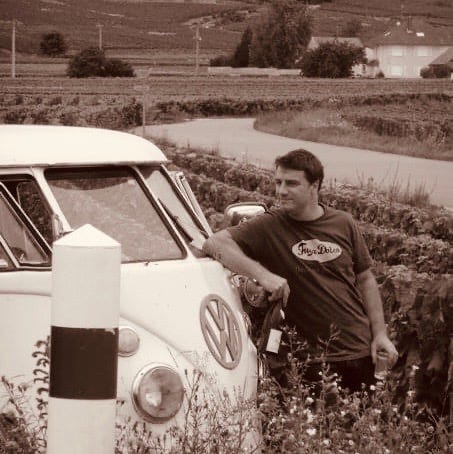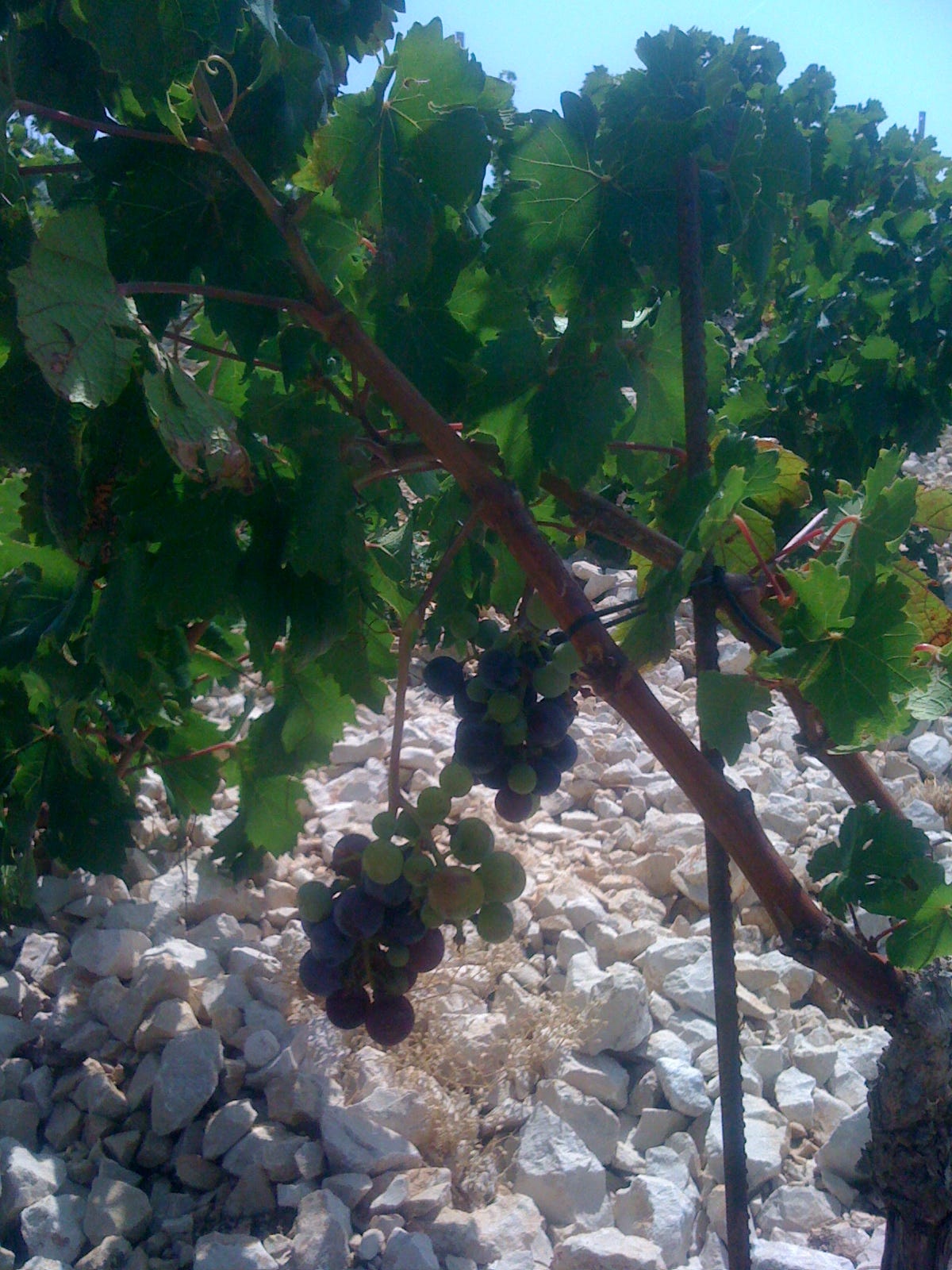Delusions of Flavour - the story of a beautiful red wine from Dalmatia, Croatia
Winemaker Mike Pulley left a successful corporate career to make beautiful wine in a tiny corner of Dalmatia. He calls his wine "Delusional" but it tastes divine
“I was connected to the Dalmatian soil when I first stepped upon it, long before I knew my bloodline came from there. Delusional by nature or nurture?”
Winemaker Mike Pulley fell in love with the wines of Dalmatia, years before he discovered that he came from Croatia. A mix of coastal and inland areas from Zadar south to Dubrovnik, Dalmatia is a fascinating wine growing region, with more indigenous grape varieties and old vines than any other part of Croatia. Pulley bought a vineyard near Šibenik, halfway between Zadar and Split and today makes exquisite wine from the lesser known indigenous Babić grape. His wines have an unusual and intriguing name – Delusional.
Babić is a dark-blue-skinned grape varietal grown in very small amounts in Northern Dalmatia – particularly in the area around Šibenik, where Pulley’s vineyards can be found. It is not nearly as well known as its close Croatian relative Plavac Mali, but has lovely freshness and acidity, which allow it to be made into elegant wines.
When grown in fertile soil, Babić can become rather flabby and blousy. It’s a vine that prefers to fight for survival. Where soil is poorer, the flavour of the grapes becomes leaner and more beautiful. The karst limestone vineyards that Pulley owns, create the perfect terroir.
Last week I went to London Wine Fair. After a superb day, I was on my way home, when I bumped into Mike. I had no idea who he was, but he took me to his stand and persuaded me to try his red wine. I loved it instantly.
Delusional Babić, in contrast to its name, is extremely well-balanced, an enticing mixture of control and abandon. It has pure notes of cherry, something slightly tobacco-flowerish, a hint of cough mixture and a backdrop of graphite pencil. These are all flavours that I appreciate individually in red wines. Combined, they are utterly delicious. It’s quite marvellous.
I would be perfectly happy to down quantities of this wine without food. It’s not heavy and it isn’t blaring with alcohol either. If you were to pick dishes to pair with it, I would say rabbit, chicken (not a cream sauce), salmon, grilled sardines, eggs, ceps. It feels like you could drink it in the heat, so might be a fun barbecue wine too.
I adored this wine so much, I almost didn’t write about it, as Mike doesn’t make a huge amount and I wasn’t sure I wanted to share. But then, luckily for you lot, my good nature took over.
Meet Mike Pulley and his glorious, delicious and surprisingly well-priced Dalmatian wine.
Tell me about your winemaking journey – how did you end up in Croatia?
As a student, I backpacked around Europe one summer and jumped on a ferry from Ancona. I ended up in the famous walled city of Dubrovnik in what was then called Yugoslavia.
When I moved to London 25 years ago, the first place I visited in Europe was the island of Korcula. I came across some small family wineries that were making some very special wines with the indigenous grapes and I was captivated.
I spent the next decade becoming obsessed with small production wines and took frequent trips around Europe in an old 1960’s VW camper van, visiting wineries in Burgundy, Beaujolais, Languedoc, the Loire and then on to Slovenia, and Croatia.
Croatia, and especially Dalmatia, captivated me with its rawness, its natural beauty and approach to things.
A little over 15 years ago, I came across a red grape native to the Northern Dalmatian coast around the city of Šibenik called Babić and I was blown away. I had never had anything like it before and shortly thereafter I decided to buy a piece of the place and plant my own vines.
Why is your wine called “Delusional”?
You have to be a bit delusional to follow your dreams and ditch your day job. I gave up a perfectly good corporate career to pursue making wine from a grape nobody outside of Croatia has ever heard of, without a proper education in winemaking, capital, or a knowledge of the local language or customs. I was quite delusional about the amount of work it would take to get there.
There is a characteristic of the people that you find in Dalmatia, a certain stubbornness to make something out of virtually nothing, against all odds. When you see how little grape juice you get out of the stark rocky terrain in this area, but how much potential there is to turn it into something beautiful, you start to understand why the people are like this.
I was adopted at birth in America, and did not find out I was of Croatian descent until long after I had been there for the first time. It was even after I bought the first piece of land and planted my first vines that I finally met my birth mother, my sister and my grandmother and the rest of the family. I was connected to the Dalmatian soil when I first stepped upon it, long before I knew my bloodline came from there. Delusional by nature or nurture?
Tell me about your vineyard?
The most distinctive aspect of the vineyards, which overlook the Adriatic Sea, is the porous Karst Limestone with a tiny bit of Terra Rossa soil. It is very hard work for the vines to survive between the earth, sun, and wind, but this is where the Babić grape shines in terms of its potential for finesse and complexity.
And your winery?
We are really quite small, I have two hectares of land and around 15,000 vines and produce less than 5,000 bottles so as you can see, we are a micro winery. Everything is done by hand.
I first planted the vines by hand with the help of my dear recently departed friend Zdenko, a local from the village, who spent his life as an international seaman and spoke with a wonderful “boat-learned English.”
As I tried to explain my philosophical approach on how I wanted to farm and produce the wine, it was a bit of a struggle translating and getting my points across. I talked about organic and doing everything naturally, his response was simply “but that is the way we have always done it here.”
Tell me specifically about the Babić – how is it made?
With this particular wine I wanted to do something a little bit different and achieve a freshness and lightness, a sweet-tart balance of sour cherries and pomegranate, but with layers of complexity and very earthy at the end. It took a while to build it from the work in vineyard to fermentation and throughout the ageing process.
- five years in total, as it is drinking now.
This was the first time I made the harvest decision based purely by taste, I had an idea in my head of what I wanted in the end, so it was a bit more intuitive approach than I had taken previously. Blending the wine from the different barrels involved the palates and expertise of my local winemaking friends, which is always the best and most interesting part of the whole process to taste and to speculate on how it will condition in the bottle
Any plans for the future?
We are small and want to keep it that way to preserve the personal touch that this sort of scale can afford. That said, there is a wonderful opportunity to make the most of what we have here so I plan on expanding it a bit.
Currently we have a small shop in a stone building in the village where we get to meet people from around the world and over a bottle or two of wine, rather than just serving a formal set tasting. The shop is part of an old castle ruins and we are looking to renovate another bit of the building, so we can host dinners with the winemaker.
What are the joys and challenges of winemaking in Croatia?
My greatest joy is interacting with the other people around me. I am very excited about up-and-coming winemakers in the area, they have a world-view and many have trained abroad, but still are committed to preserving and promoting the indigenous grape varieties.
Winemaking has been going on in Croatia for several thousand years, but to me this is a very exciting moment to be here. It seems like Croatia is the next greatest thing in the wine world. I feel like I really got lucky in terms of timing to be making wine here at this point in history.
If you want to buy Mike’s wines in UK or Europe, this is the website:
contact person: Nenad Trifunovic Nenad@winenadmore.com/+385 91 4550 399








The best on Delusional, thanks!! It prompted me to share what I wrote in my "Jung's Demon" novel about two Sicilian wines. Hope you wouldn't mind:
PIETRA SACRA – excites like a young, salacious peasant girl. Deep in what she offers, suggesting what she proposes is much more than what’s obvious. The wine is full, strong after 10 years in the bottle, as strong as her legs and arms. Bouquet is terrestrially opulent, coming from the depths of clay from which its grape grew, as sumptuous as curves and breasts of our little lustful rustic desire fantasy dressed in her white linen shirt.
Tannin in the Pietra Sacra wine is like a whiff coming from the Mediterranean Sea, which gives it another layer of beauty; the tongue and the palate sing as they’re smooching her. Very pleasant to imbibe. A feel of tipsiness: Dionysian. It’s somehow “raw”—it feels like one drinks it directly from a moist, rustic soil as it takes it from the lips of your peasant girl.
With Pietra Sacra, one must fuck in the hay.
MILLE E UNA NOTE – this (quite expensive) wine is like a lustful—albeit a tad aged and therefore even more exciting—rather perverted aristocrat. Now at a certain mature age, her bright blue eyes radiate life experiences. She’s all smooth, velvety and, dare I say, somewhat cunning. But what a charm she possesses. She knows the game of life better than you could imagine. The wine itself has an intense, exquisite ruby color. Its bouquet mesmerizes you. You can whiff a scent of the celebrated licorice amidst a tad stronger blackberry and plum notes. One even senses a chocolate in it. Ahh, il cioccolato Siciliano, how could anyone live without you?
Mille e Una Note makes you wish to be able to swim in it, to immerse yourself in lustful Dionysian games or at least to frantically dance under the full moon, like the renegade dervishes of yesteryear used to do.
Then you take a sip. You imbibe it gently, almost timidly kissing the lips of your aristocrat lady as it all starts slowly and deliberately. Think of Gioachino Rossini and “William Tell Overture.” It does not overwhelm you at the start but then, with every bit (a sip, a kiss…) it lures you even deeper into its mystery, all the way up to the overpowering crescendo. Yes, she is reserved at first, our gorgeous aristocratic lady, but once she opens herself, she takes you to the heights of sensual pleasures you could have only dreamt of before encountering her.
Mille e Una Note is big, an exceptionally refined wine. It is as smooth and as silky as our aristocrat. So, with this big, red ruby Sicilian wine, one ought to fuck in silk.